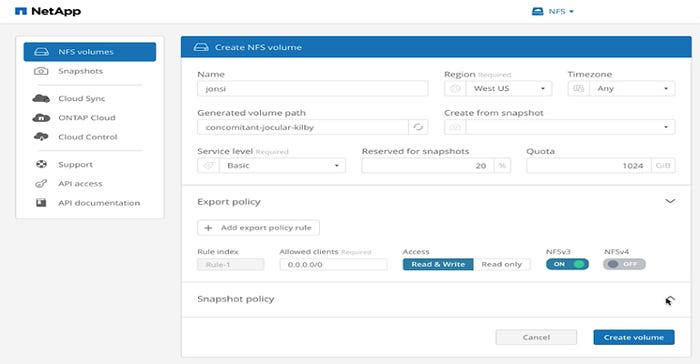At NetApp Insights, company officials fleshed out NetApp's new Cloud Volumes and Azure File Service enterprise storage services.
October 24, 2018

NETAPP INSIGHT — Building on its evolving enterprise-storage-as-a-service strategy, NetApp has fleshed out its new Cloud Volumes service portfolio offered in the Amazon, Microsoft and Google public clouds.
At the annual NetApp Insight technical conference for customers and partners this week in Las Vegas, officials outlined the forthcoming release of Cloud Volumes, which brings NetApp’s discrete enterprise storage offerings as a service in all three public clouds.
NetApp first revealed Cloud Volumes at last year’s Insight conference, initially for Microsoft Azure as an enterprise file service, but subsequently, Amazon Web Services and Google Cloud have jumped on the bandwagon.
Cloud Volumes is a key pillar of NetApp’s Data Fabric strategy, outlined four years ago to transition its storage portfolio into a hybrid, multicloud platform. AWS rolled out its Cloud Volumes preview earlier this year and Microsoft opened its iteration, Azure NetApp Files, in July. The preview of Cloud Volumes will also start to appear in Google Cloud next month.
“We are taking the Data Fabric to the next level, simplifying multicloud, hybrid cloud by connecting the world’s biggest clouds with the best enterprise private cloud, built on NetApp HCI, applications, infrastructure and data all with a few simple clicks,” NetApp CEO George Kurian said in the opening keynote on Tuesday.
Cloud Volumes will enable traditional NetApp resellers and integrators as well as MSPs to help extend customer storage environments and build new ones, NetApp’s U.S. VP for America partner sales, Jeff McCullough, told Channel Futures.
“It’s a great opportunity for our partners who already know how to deliver ONTAP to build and sell cloud solutions attached to on-premises storage,” McCullough said. “It’s a great way to accelerate revenue. While I haven’t met a partner that doesn’t have a cloud strategy, many of them are still working on some of those strategies. What we offer is the opportunity to take a vanilla cloud resell motion and up-size it to expose new workloads.”

The rollout of Cloud Volumes on the three major public clouds has a decidedly distinct approach with each provider. After revealing Cloud Volumes with Microsoft at last year’s NetApp Insight, AWS took a major interest in offering it as well, and ultimately was the first to start previewing the service earlier this year. Cloud Volumes is now in the AWS Marketplace, and NetApp outlined extended global geographic reach and a new backup service.
AWS offers Cloud Volumes in the AWS marketplace as a NetApp offering, while Azure NetApp Files is a Microsoft-branded service.
“NetApp isn’t really part of the transaction; they are in the back end of that service, but the transaction and service is completely through Microsoft,” said Kent Christensen, data center and cloud practice director at Insight Enterprises, a NetApp and Microsoft partner that has previewed the service.
Christiansen added that Azure NetApp Files will appeal to enterprises seeking scale out file-based services that require high performance such as big-data applications that are Hadoop-based.

NetApp CEO George Kurian on stage at NetApp Insight, Oct. 23.
NetApp CEO George Kurian on stage at NetApp Insight, Oct. 23.
“If you’re in the Azure portal, it’s like bringing up any other service,” he said.
Microsoft will offer automated resource deployment from the Azure portal through REST APIs and access to a CLI. Brendon Howe, NetApp’s SVP and general manager for cloud storage services, told Channel Futures that Azure NetApp Files will indeed offer high-performance connectivity to applications that use file-based data such as machine learning and data analytics — including Microsoft’s Azure HD Insights.
Noting Microsoft’s recent revelation that more than half of all data in Azure is now running on Linux servers, Howe said Azure NetApp files will also lend themselves well to those who need a Linux file service in Azure.
“If you think the most basic use cases for people running Linux in the Azure Cloud, we are a fantastic – and in some places the only – option for file data that require NFS connectivity,” Howe said. “They don’t have it today. They have the Azure file service, but it’s based on SMB and CIFS Windows file shares. At a very base level, it’s as simple as we give them the opportunity to have Linux file shares alive and well within Azure, that can be high performance or can be quite basic, depending on what they need.”
The service also will lend itself to organizations looking to extend their NetApp on-premises storage to Azure in a hybrid scenario, Howe noted.
“The fact that a customer might be running NetApp on premises, this provides great linkage into the Azure cloud and gives them the opportunity to extend the in a hybrid configuration,” he said.
Microsoft is extending its Azure NetApp Files limited preview with expanded coverage to the U.S. East and U.S. West 2 Azure data-center regions set to become available later this year.
While Cloud Volumes services delivered by AWS, Microsoft and Google are consumption-based, NetApp also showcased upgrades to its capacity-based native cloud storage service, Cloud Volumes ONTAP, previously known as ONTAP Cloud, available in AWS and Azure.
NetApp outlined new services for Cloud Volumes ONTAP, including a cloud-storage tiering option to optimize the location of data, support for containers via NetApp’s open-source Trident platform and the addition of the company’s SnapLock Enterprise.
SnapLock is NetApp’s write-once, read many (WORM) data-management capability, intended for those with governance requirements and for protection against ransomware and other malicious attacks. A high-availability option for Cloud Volumes ONTAP also is now available in the extended Azure preview.
About the Author(s)
You May Also Like


